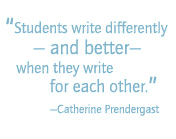Methods: Readings
Ethnographic Methods
Writing Ethnographic Fieldnotes
Emerson, Robert M., Rachel L. Fretz, and Linda L. Shaw.
[Selections from Chapter 1 "Fieldnotes in Ethnographic Research" Pp 1-16, and Chapter 4 "Writing Up Fieldnotes II: Creating Scenes on the Page" Pp 100-107].
Chicago: Chicago University Press, 1995.
The first excerpt addresses issues of objectivity in participant observation and the inherent selectivity of note-taking. The authors describe ethnography as "the inscription of participatory experience" and call attention to the inseparability of ethnographic findings and methods. The second excerpt addresses the ways ethnographers begin to make sense of their data while they are collecting it through in-process analytic writing.
Cancer in the Community: Class and Medical Authority
Balshem, Martha Levittan.
[Chapter 3, "Project CAN-DO" Pp 55-68].
Washington, D. C.: Smithsonian Institution Press, 1993.
In Chapter Three of her ethnography of a community-based cancer prevention program in Philadelphia, Balshem grapples with her acceptance into the study community and her position as both a health educator and ethnographic researcher.
Wisdom Sits in Places: Landscape and Language among the Western Apache
Basso, Keith.
[Chapter 2 "Stalking with Stories" Pp 58-65].
Albuquerque: University of New Mexico Press, 1996.
Basso's beautifully written chapter directs attention to the "stories" told by and about the environments in which we live. While the chapter discusses the cultural construction of a natural landscape, Basso's arguments can be extended to considering the built environment of the college campus.
My Freshman Year: What a Professor Learned by Becoming a Student.
Nathan, Rebekah.
[Especially Chapter 1 "Welcome to AnyU" Pp 1-18, and Chapter 4 "As others See Us " Pp 67-89]. Ithaca: Cornell University Press, 2005.
"Rebekah Nathan" is the pseudonym of Cathy Small, an anthropologist and college professor who enrolled at her own university for a year of participant observation as a college freshman. Chapters of the ethnography address residence hall life, diversity and community on campus, students' study habits, work, and leisure activities as well as students ' motivations and goals regarding their college education.
Call to Home: African-Americans Reclaim the South.
Stack, Carol.
[Selection from Chapter 1, "Burdy's Bend" Pp 1-7]. New York: Basic Books, 1995.
These first few pages of Stacks' ethnography offer a richly-textured ethnographic description of a local setting and a social landscape as it is transformed over time.
"Discourse, Culture, and Social Structure: Some Basics."
Urciuoli, Bonnie.
Handout, n.d.
Urciuoli's brief essay provides students with a starting point for discourse analysis. She directs students to consider a message 's cultural frame, its relationship to social institutions, and the relationship(s) between who sends and who receives it. She highlights six stylistic forms, or "phrasing devices," that impact how a message is understood.
Sidewalk.
Duneier, Mitchell.
[Selections from "Introduction" Pp 1-14, and Appendix 1 "Statement on Methods" Pp 333-357]. New York: Farrar, Strauss and Giroux, 1999.
Sidewalk is Duneier's award-winning ethnography of second-hand magazine vendors on New York City streets. These selections detail Duneier's participant observation and relationships with the vendors as well as his approach to ethnography, which he calls an "extended place method." In this attempt to link micro and macro analyses, Duneier's fieldwork extended beyond the street corner to key places and spaces (such as city council offices and business development agencies) that played roles in constructing the experiences of the vendors.
Additional resources on ethnographic methods available in the U of I Library can be found at Ethnography of the University at the University Library.


